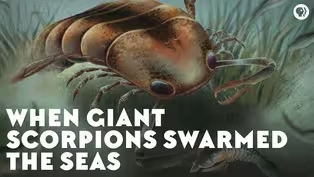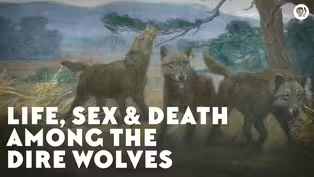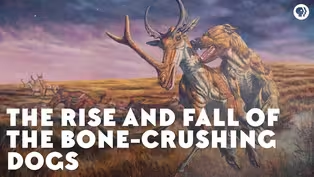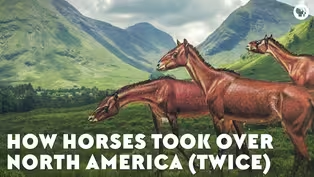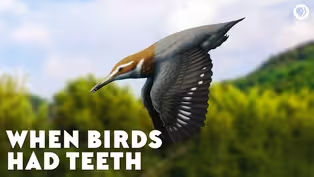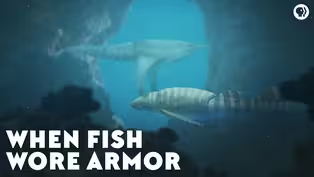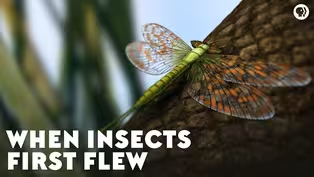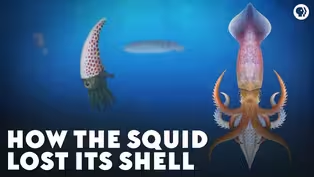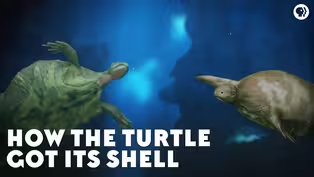
When Giant Amphibians Reigned
Season 1 Episode 60 | 9m 51sVideo has Closed Captions
A look at when Temnospondyls Amphibians existed for 210 million years
Temnospondyls were a huge group of amphibians that existed for 210 million years. And calling them ‘diverse’ would be putting it mildly. Yet in the end, two major threats would push them to extinction: the always-changing climate and the amniote egg.
Problems playing video? | Closed Captioning Feedback
Problems playing video? | Closed Captioning Feedback

When Giant Amphibians Reigned
Season 1 Episode 60 | 9m 51sVideo has Closed Captions
Temnospondyls were a huge group of amphibians that existed for 210 million years. And calling them ‘diverse’ would be putting it mildly. Yet in the end, two major threats would push them to extinction: the always-changing climate and the amniote egg.
Problems playing video? | Closed Captioning Feedback
How to Watch Eons
Eons is available to stream on pbs.org and the free PBS App, available on iPhone, Apple TV, Android TV, Android smartphones, Amazon Fire TV, Amazon Fire Tablet, Roku, Samsung Smart TV, and Vizio.
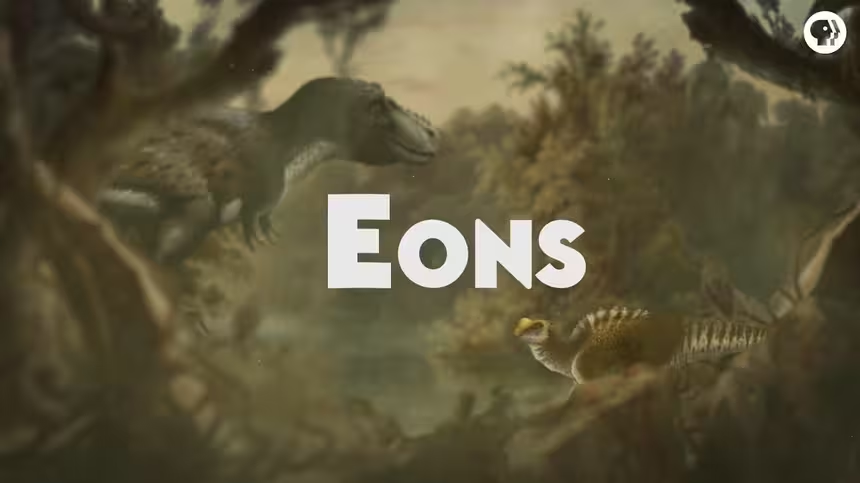
Welcome to Eons!
Join hosts Michelle Barboza-Ramirez, Kallie Moore, and Blake de Pastino as they take you on a journey through the history of life on Earth. From the dawn of life in the Archaean Eon through the Mesozoic Era — the so-called “Age of Dinosaurs” -- right up to the end of the most recent Ice Age.Providing Support for PBS.org
Learn Moreabout PBS online sponsorshipMore from This Collection
Ancient Fauna, Flora & Fungi
When Giant Scorpions Swarmed the Seas
Video has Closed Captions
Sea scorpions thrived for 200 million years, coming in a wide variety of shapes and sizes. (11m 38s)
Life, Sex & Death Among the Dire Wolves
Video has Closed Captions
Dire wolves were real! Their remains taught us a lot about how they lived. (9m 15s)
The Rise and Fall of the Bone-Crushing Dogs
Video has Closed Captions
What happened to the biggest dogs that ever lived? (8m 29s)
How Horses Took Over North America (Twice)
Video has Closed Captions
Horses vanished from North America for 10,000 years until a mammal brought them back. (9m 8s)
Video has Closed Captions
How did Archaeopteryx relate to today’s birds? Its teeth provide a major clue. (11m 29s)
Video has Closed Captions
420 million years ago, some fish wore armor – and it may have served a surprising purpose. (9m 37s)
Video has Closed Captions
Insects were the first animals to fly. Scientists are still working on how it happened. (8m 38s)
Video has Closed Captions
Before a group of fish could live on dry land, they acquired the ability to breathe air. (8m 40s)
Why Triassic Animals Were Just the Weirdest
Video has Closed Captions
Why the Triassic was full of creatures that look a lot like other, more modern species. (9m 7s)
Video has Closed Captions
Ancestors of cephalopods all had shells until it proved to be their biggest weakness. (8m 5s)
Video has Closed Captions
Where did turtles come from? And how did the they get their shells? (8m 29s)
Providing Support for PBS.org
Learn Moreabout PBS online sponsorship120 million years ago, southern Australia sat within the Antarctic circle.
And for about half the year, the skies were dark, and the land was intolerably cold.
But it was here, near the bottom of the world, that the last member of a great dynasty made its final stand.
Koolasuchus was a huge, stream-dwelling carnivore that could grow to almost five meters long and looked sort of like a giant salamander.
As far as paleontologists know, this was the last temnospondyl ever to grace the earth.
Temnospondyls were a huge group of amphibians that existed for 210 million years.
And calling them ‘diverse’ would be putting it mildly.
Their ranks included armor-plated killers, thin-snouted fishers, and a cute little oddball with a sail on its back.
Creatures like these were among the most successful early tetrapodomorphs, the group that includes all four-limbed vertebrates and their relatives.
At a time when any animals with legs and backbones were still pretty new, temnospondyls did incredibly well for themselves.
For hundreds of millions of years, these pioneers thrived and diversified on dry land, in bodies of freshwater, and even in the oceans.
And the largest of them may have been the biggest amphibians that ever lived.
Yet in the end, two major threats would push the temnospondyls—including the resilient Koolasuchus—to extinction.
One was the world’s always-changing climate.
The other was a development that altered the course of life’s history on planet earth: The amniote egg.
The reign of these amphibians began in what’s now Scotland, around 330 million years ago, when a new kind of tetrapodomorph arrived on the scene.
That’s where the little, twenty-centimeter Balanerpeton became the first known temnospondyl to appear in the fossil record.
Another was Dendrerpeton, whose name means “tree creeper”—because its remains are often found inside the fossils of hollowed-out tree trunks.
Both animals had hard, sturdy limb and ankle bones, indicating that they mainly lived on dry land, like modern red-backed salamanders do.
So, we don’t know what the common ancestor of all temnospondyls was, but based on the anatomy of these two early species, scientists think it was probably terrestrial.
With their stronger limbs, early temnospondyls were better-equipped for walking on land and wading through shallow water than some of the more fish-like tetrapods— like Acanthostega —that had come before them.
But temnospondyls didn’t live on land all of the time.
They’re considered amphibians, and amphibians are reproductively tied to the water.
They tend to go through an aquatic stage when they’re larvae, and a terrestrial or semi-aquatic stage when they’re adults.
And like fish, amphibians lay eggs that don’t have protective shells.
The outermost layer of fish and amphibian eggs is a thin membrane that doesn’t retain water very well.
So if the eggs don’t stay wet, they dry out -- which is one reason most living amphibians lay their eggs in water.
And back in the early Carboniferous Period, earth was an amphibian’s paradise.
It was warm and lush, teeming with swamplands.
And it was in this environment where temnospondyls truly thrived.
By the end of the Carboniferous, they had become the single most diverse group of tetrapodomorphs on earth.
But a lot of them looked very different from amphibians we know.
For one thing, some of them had claws--a trait that modern amphibians usually lack.
But more importantly, living frogs, toads, and salamanders generally have skin that’s thin and moist, with no scales.
Through this permeable layer, they absorb water and oxygen.
But many temnospondyl species were covered in scales.
And some had large, plate-like coverings on their backs or their bellies.
So, paleontologists are still figuring out whether these creatures breathed through their skin like modern amphibians do, even with those scales and plates.
Now, despite all these variations among species, temnospondyls did share a few key traits.
For example, they all had a set of large openings on their palates.
Most of them had broad, flat skulls.
And many had big tusks protruding from their lower jaws.
In fact, in some species, like Africa’s Nigerpeton, the tusks actually poked through openings in the top of the skull!
Now, as the Carboniferous Period gave way to the Permian, the climate became more volatile, and glacial activity increased at the poles.
But things stayed warm and wet year-round near the equator, so temnospondyls still did OK. And although the first temnospondyls lived on dry land as adults, it’s in the late Carboniferous and early Permian when we see forms that were even better adapted to life in the water.
Take Trimerorhachis, which looked like an overgrown axolotl.
It had a huge head but very short limbs, and scientists have found that many of its bones weren’t fully ossified.
That means its bones didn’t completely harden as they developed from cartilage.
And this is a sign that Trimerorhachis was largely aquatic.
Because you don’t need a fully ossified skeleton if you spend most of your time in the water.
It’s only essential if you’re big and terrestrial.
Another major player in Permian waters was Prionosuchus, a genus from Brazil.
It probably used its long, narrow snout to catch fish in freshwater, like the gharial does today.
It’s only known from incomplete material, but some scientists think Prionosuchus was about five meters long, and others think it could’ve been almost twice that length -- making it larger than any crocodile alive today.
And aquatic temnospondyls weren’t limited to freshwater.
Ocean-dwelling amphibians don’t exist today, but fossils of temnospondyls have been found in marine deposits.
Iberospondylus, for example, was a Carboniferous genus that thrived in coastal environments in what’s now Spain.
And it, along with other aquatic amphibians, was equipped with an an amazing apparatus that tells us that it lived in the water: a lateral line system.
Sharks and some other fish today have networks of sensory organs that detect underwater vibrations, movement, and pressure changes.
And these structures leave distinct grooves and pits in the skull, which are also found in some temnospondyls.
But others bear no trace of this system, indicating that, as adults, those animals lived on land.
This includes what’s probably the Permian’s most famous amphibian: Eryops, found in Texas and the southwestern United States.
With big legs and strong, well-ossified bones, it spent at least some of its adult life on land, where it hunted with curved, bladed teeth.
The biggest species of Eryops was more than two meters long, but some terrestrial temnospondyls were much smaller.
Platyhystrix lived in the same time and place as Eryops, but it was only 60-centimeters long and was quite different in a lot of other ways, too.
It belonged to a subgroup of smaller temnospondyls called the dissorophoids, and it had short, stubby legs and … a sail on its back.
Actually, Platyhystrix looked like a miniature version of another creature that shared its habitat: the stem-mammal known as Dimetrodon.
And Dimetrodon was among a group of ascendant animals that would turn out to have a distinct advantage over the temnospondyls, as the climate began to change.
Toward the end of the Permian, the planet became increasingly dry.
Irregular rainfall led to a decline in swamplands in many corners of the world.
And this was bad news for the temnos, because, again, their mode of reproduction bound them to the water.
Even terrestrial species like Eryops had to lay their eggs in bodies of water, which were now growing more scarce.
But Dimetrodon didn’t have this problem.
In all probability, it reproduced by laying amniotic eggs.
And these things were an evolutionary game-changer.
Now, there are different types of amniotic eggs.
Some are soft and leathery, and others have a mineralized shell that’s usually made of calcium.
Either way, this outer layer helps protect the embryo from damage.
But more importantly, the shell also prevents the embryo from drying out.
And it acts as a semi-permeable barrier, letting oxygen in and carbon dioxide out.
Now, reptiles are amniotes, and so are mammals.
But at some point, mammals, as well as some reptiles, took this a step further with the ability to give live birth.
And honestly, I could do a whole episode just about that transition.
That's actually a really good idea, hold on.
Remind me to do an episode about placentas Ok I'll remind you OK, now let’s get back to Dimetrodon.
Unlike the temnospondyls, these early amniotes were free to reproduce far from the water, by laying eggs with protective shells, which were probably more leathery than mineralized.
But on an increasingly dry planet, that gave amniotes a critical advantage.
And although the first amniotes evolved in the Carboniferous, it was during the Permian that they started taking over the world’s land environments.
As the Permian progressed, amniote predators like Dimetrodon, Ophiacodon, and eventually saber-toothed gorgonopsians became widespread.
Unable to compete with these amniotes, and facing a harsh new climate, terrestrial temnospondyls either vanished outright or returned to the water.
Now, fans of this channel will know that the Permian ended 252 million years ago with the biggest mass extinction of all time, the so-called “great dying,” which wiped out 96 percent of marine life and 70 percent of land-based organisms.
By the time this catastrophe occurred, most lineages of temnospondyls had already gone extinct, under pressure from the amniotes.
But afterward, in the Triassic, some amphibians still held on.
One lineage of aquatic temnospondyls proliferated in the early Triassic: the Stereospondyls.
They took over niches that had been left vacant by the Great Dying, and radiated across Pangea, onto every modern continent, into a host of subgroups.
These gave rise to the marine trematosauroids, which likely fished in coastal waters, and the freshwater metoposaurs.
And their appearance in the fossil record corresponds with the Carnian pluvial episode, that period of intense seasonal rainfall that went on for two million years.
This phenomenon gave metoposaurs plenty of lush, watery habitats, in what had been a drying world.
As a result, some species became almost staggeringly common: Mass bonebeds containing hundreds of metoposaurs have turned up in Africa, Europe and North America.
But you know by now that all success is fleeting.
Aquatic temnospondyls managed to hang on for tens of millions of years by sticking to watery habitats and avoiding the amniotes on land.
But all that changed after aquatic amniotes started to spread.
In the mid-Triassic, around the world, aquatic ecosystems began to be overrun with swimming reptiles -- from phytosaurs to the first turtles.
Gradually, the remaining freshwater and marine temnospondyls found themselves displaced.
The fossil record shows a global decline of these once-successful amphibians and the rise of ecologically similar, croc-like reptiles during the Triassic and Jurassic.
By the early Cretaceous, the temnospondyls had vanished from every continent.
Every continent, that is, except for Australia, whose southern wilds were still home to the tenacious Koolasuchus.
For a time, the waters here were too cold for crocodylians.
But eventually, the climate warmed, and by about 113 million years ago, crocodylians had arrived with it.
The last known Koolasuchus appears in the fossil record shortly after that, 110 million years ago.
But, did the legacy of the temnospondyls die with it?
Maybe not.
There may have been an epilogue.
All modern amphibians—frogs, toads, salamanders, and the legless caecilians—belong to the same subclass of animals known as the Lissamphibia.
And some paleontologists think that some or all of the lissamphibians are descended from the dissorophoids, that group of smaller temnospondyls.
Dissorophoids tended to have wide heads, and the cavities in their skulls indicate that they, like frogs, had large eardrums.
And some of them, like cute little Gerobactrachus had frog-like teeth as well.
But in natural history, things are seldom clear-cut.
One popular hypothesis holds that, while frogs and salamanders evolved from dissorophoids, caecilians descended from a different group of amphibians.
Right now, there’s no real consensus about where modern amphibians came from.
Maybe the temnospondyls gave rise to them, and maybe they didn’t.
Still, it’s fascinating to wonder about the legacy of these, the amphibians that once reigned over the ancient world.
On a warm evening, when you hear frogs croaking and chirping, you just might be listening to the living successors of Koolasuchus and the other temnospondyls joining their voices in chorus.


- Science and Nature

A documentary series capturing the resilient work of female land stewards across the United States.












Support for PBS provided by:

